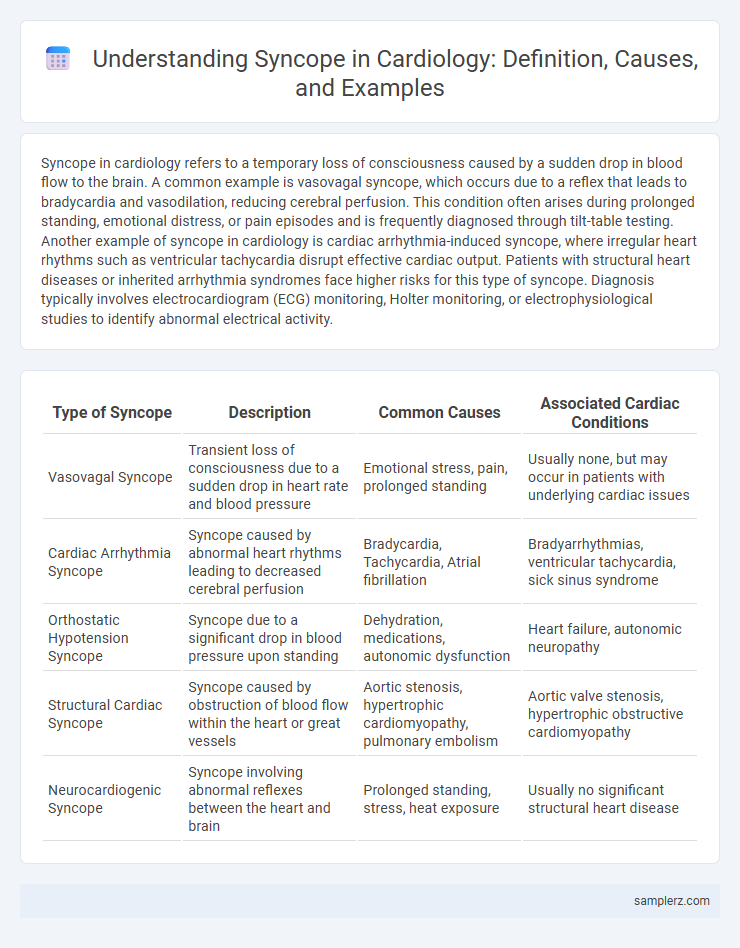Syncope in cardiology refers to a temporary loss of consciousness caused by a sudden drop in blood flow to the brain. A common example is vasovagal syncope, which occurs due to a reflex that leads to bradycardia and vasodilation, reducing cerebral perfusion. This condition often arises during prolonged standing, emotional distress, or pain episodes and is frequently diagnosed through tilt-table testing. Another example of syncope in cardiology is cardiac arrhythmia-induced syncope, where irregular heart rhythms such as ventricular tachycardia disrupt effective cardiac output. Patients with structural heart diseases or inherited arrhythmia syndromes face higher risks for this type of syncope. Diagnosis typically involves electrocardiogram (ECG) monitoring, Holter monitoring, or electrophysiological studies to identify abnormal electrical activity.
Table of Comparison
| Type of Syncope | Description | Common Causes | Associated Cardiac Conditions |
|---|---|---|---|
| Vasovagal Syncope | Transient loss of consciousness due to a sudden drop in heart rate and blood pressure | Emotional stress, pain, prolonged standing | Usually none, but may occur in patients with underlying cardiac issues |
| Cardiac Arrhythmia Syncope | Syncope caused by abnormal heart rhythms leading to decreased cerebral perfusion | Bradycardia, Tachycardia, Atrial fibrillation | Bradyarrhythmias, ventricular tachycardia, sick sinus syndrome |
| Orthostatic Hypotension Syncope | Syncope due to a significant drop in blood pressure upon standing | Dehydration, medications, autonomic dysfunction | Heart failure, autonomic neuropathy |
| Structural Cardiac Syncope | Syncope caused by obstruction of blood flow within the heart or great vessels | Aortic stenosis, hypertrophic cardiomyopathy, pulmonary embolism | Aortic valve stenosis, hypertrophic obstructive cardiomyopathy |
| Neurocardiogenic Syncope | Syncope involving abnormal reflexes between the heart and brain | Prolonged standing, stress, heat exposure | Usually no significant structural heart disease |
Common Cardiac Causes of Syncope
Cardiac syncope frequently results from arrhythmias such as ventricular tachycardia and heart block, which disrupt effective blood flow to the brain. Structural heart diseases including aortic stenosis and hypertrophic cardiomyopathy are also prominent causes, leading to decreased cardiac output during exertion or stress. Identifying these conditions through electrocardiography and echocardiography is critical for preventing recurrent syncopal episodes and sudden cardiac death.
Vasovagal Syncope: A Typical Presentation
Vasovagal syncope, the most common type of fainting episode, occurs due to a sudden drop in heart rate and blood pressure triggered by stress, pain, or prolonged standing. This transient loss of consciousness typically presents with prodromal symptoms such as dizziness, nausea, and sweating before collapse. Understanding the pathophysiology involving autonomic nervous system dysfunction helps guide effective management and prevention strategies in cardiology.
Arrhythmia-Induced Syncope Cases
Arrhythmia-induced syncope in cardiology typically results from transient cerebral hypoperfusion caused by abnormal heart rhythms such as ventricular tachycardia or bradyarrhythmias. Patients with conditions like atrial fibrillation or sick sinus syndrome often present with sudden loss of consciousness linked to these arrhythmic events. Continuous ECG monitoring and electrophysiological studies are essential for diagnosing and managing syncope related to cardiac arrhythmias.
Syncope Due to Structural Heart Disease
Syncope due to structural heart disease commonly occurs in conditions such as hypertrophic cardiomyopathy, aortic stenosis, and dilated cardiomyopathy, where impaired cardiac output leads to transient cerebral hypoperfusion. Ventricular arrhythmias associated with structural abnormalities can also precipitate sudden loss of consciousness. Early diagnosis with echocardiography and cardiac MRI is crucial for risk stratification and management to prevent recurrent episodes and sudden cardiac death.
Case Study: Syncope From Aortic Stenosis
Syncope caused by aortic stenosis often presents as transient loss of consciousness due to decreased cerebral perfusion during exertion. A notable case involves a 68-year-old male with severe aortic valve narrowing, experiencing repeated episodes of syncope triggered by physical activity, confirmed through echocardiography and hemodynamic monitoring. Treatment with aortic valve replacement alleviated symptoms by restoring normal blood flow and preventing future syncope episodes.
Bradyarrhythmias and Syncope Incidence
Bradyarrhythmias, including sinus node dysfunction and atrioventricular block, are significant causes of syncope due to impaired cardiac output and cerebral perfusion. Studies indicate that syncope incidence related to bradyarrhythmias accounts for approximately 10-20% of all syncope cases evaluated in cardiology clinics. Early diagnosis through electrocardiographic monitoring is critical for preventing recurrent syncopal episodes and guiding appropriate pacemaker therapy.
Tachyarrhythmias Triggering Syncope Events
Tachyarrhythmias such as ventricular tachycardia and supraventricular tachycardia frequently trigger syncope by causing rapid heart rates that decrease cardiac output and cerebral perfusion. Patients with hypertrophic cardiomyopathy or inherited channelopathies are at higher risk of syncope due to these arrhythmias. Prompt diagnosis with ECG monitoring and electrophysiological studies is critical to managing syncope and preventing sudden cardiac arrest in these cases.
Orthostatic Syncope With Cardiac Origin
Orthostatic syncope with cardiac origin occurs when a sudden drop in blood pressure upon standing is linked to underlying heart conditions such as arrhythmias, aortic stenosis, or cardiomyopathy. This type of syncope often results from inadequate cardiac output or impaired autonomic regulation, leading to cerebral hypoperfusion and transient loss of consciousness. Early diagnosis through ECG, echocardiography, and tilt-table testing is critical to managing risks of sudden cardiac events and improving patient outcomes.
Myocardial Infarction Presenting With Syncope
Myocardial infarction presenting with syncope is a critical cardiology condition where sudden cardiac ischemia leads to transient loss of consciousness. This atypical symptom occurs due to arrhythmias or acute reduction in cardiac output during the infarction event. Immediate recognition and intervention improve survival rates and reduce complications associated with syncope in myocardial infarction cases.
Diagnostic Approach to Cardiac Syncope
Cardiac syncope often results from arrhythmias or structural heart disease, requiring a detailed diagnostic approach including electrocardiogram (ECG), Holter monitoring, and echocardiography. Tilt-table testing and electrophysiological studies can aid in identifying the underlying cause when initial evaluations are inconclusive. Early diagnosis is critical for preventing sudden cardiac death and guiding appropriate treatment strategies.

example of syncope in cardiology Infographic
 samplerz.com
samplerz.com